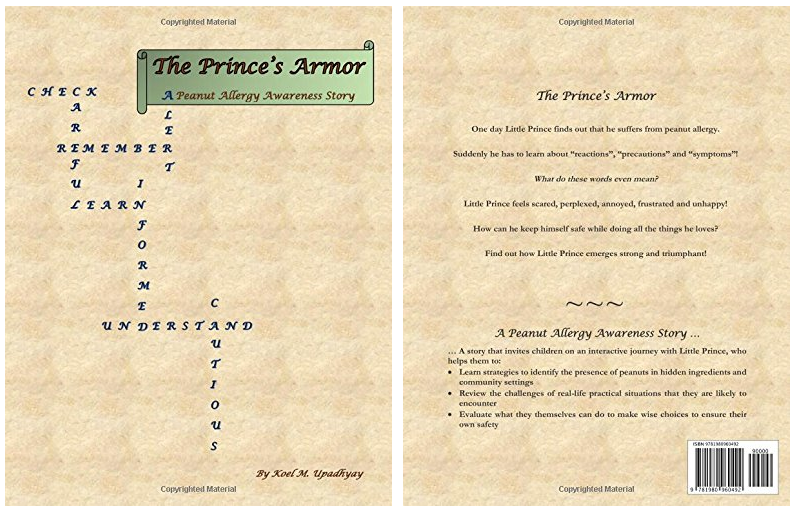Did you know that almost dying leaves footprints? It does—it leaves ones the size of Big Foot’s on steroids.
Due to life-threatening allergic reactions, I came very close to leaving my footprints in emergency rooms during both 1998 and 1999. These experiences made me question the type of footprints I could have left behind.
Developing allergies as an adult changed my life in numerous ways . . . and nearly ended it on many occasions. After pregnancy, I developed anaphylaxis, a life-threatening reaction to food allergies. If I eat any nuts, peanuts, fish, or shellfish, I become extremely dizzy within minutes, followed by a dangerous drop in blood pressure, as well as complete digestive failure. The process of discovering which foods I was newly allergic to threatened my life on a number of occasions.
On April 10, 1998, I had my first allergic reaction while inside a coffee shop in Burnsville, Minnesota. I went there to meet my first husband, Mike, for coffee. I ate a small bag of almonds while waiting for him to arrive; and within a few minutes, I became dizzy, had severe stomach cramps, and realized that voices started to fade as my world grew very blurry. Thinking I needed some fresh air, I stood up and made it outside to the sidewalk, but then fell to the ground and began vomiting. Thankfully, Mike arrived just in time to rush me to the hospital.
I could hardly move, so Mike had to carry me to the car. Neither of us had a clue what was happening to me. All I knew was that something was terribly wrong as I felt my energy and life rapidly fading away. I told Mike that I thought I was going to die.
Upon arrival at the ER, I was still too weak to move. The ER staff lifted me out of the car and brought me into the hospital. My blood pressure had dropped to 65/38 and was steadily decreasing. I was put on a resuscitation cart. I could hear doctors ask my husband if I had overdosed on drugs or if he knew what was wrong. He assured them that I hadn’t overdosed on drugs, and that no, he hadn’t a clue what had happened. While the doctors were trying to determine the reason for my rapid decline, I was unable to speak or move, and everything had become even hazier. Voices were blurred and cloudy, as forms rushed about me while numerous doctors and nurses tried desperately to save my life. My digestive system was in complete failure mode, and I had difficulty breathing. My energy was gone; everything around me faded away.
When I eventually woke up, I was hooked up to a variety of machines and drips. I felt completely overfilled with fluids the doctors had pumped into me in an attempt to save my life. Closely monitored, I spent several days on a machine that was designed to get my kidneys functioning again.
After I stabilized, the doctors and nurses informed me that it appeared I had experienced a full-blown anaphylactic reaction to some kind of food. They asked what I had eaten before the reaction, and I told them about the almonds. They warned me that if I ate almonds again, I probably wouldn’t be as lucky as I was this time because allergic reactions tend to worsen after the initial exposure. The word lucky has stuck me with over the years. However, I spent most of the first few years following this incident feeling really angry about developing food allergies. At the time, luck never crossed my mind; I was mostly flat-out mad that I couldn’t eat without fear of death.
Living with food allergies can be a challenge. I have to be extremely careful in my daily life when eating food to avoid allergens. One part of having peanut and nut allergies that is the most challenging is traveling by plane. Flying is essentially miserable and dangerous for anyone with nut allergies. Often, only peanuts are restricted on flights; however, this ban should include all nuts. There is nothing scarier than boarding a plane and sitting next to a person who has a bag of mixed nuts. I feel like I have a 50/50 chance of arriving at my destination versus forcing the plane into an emergency landing. I’ve spent years petitioning airlines to stop serving nuts and peanuts on flights, but my pleas have mostly fallen on deaf ears. Food allergies can cause a feeling of social isolation and create anxiety about flying, going to someone’s house for dinner, or dining out. I’m a mother of four boys, and no, they don’t have food allergies. At the time of writing this book, our boys are 12, 14, 16, and 18, so my days are relatively free now to work and write. I didn’t work very much out of the house until our youngest started school. For the most part, while home with the boys, I turned hobbies into some form of income-generating endeavor or have given back to the community. I’ve handmade more than 20,000 nut-free chocolate-chip cookies and have donated them to adults and kids. Plus, I’ve dedicated much of my time to children’s literacy.
In 2006, I became a food allergy spokesperson for the MedicAlert Foundation and appeared on the cover of their magazine, which was mailed to over one million members. I also helped by providing them feedback on some new bracelets for children. I was featured in One of the Gang: Nurturing the Souls of Children with Food Allergies by Gina Clowes. These were the first instances I began to let anyone outside of my family know I had food allergies and had nearly died several times. I realized that my talking about my allergies could save lives and help others.
Fast-forward to today, and the Best Ever You Network—a community that provides unique content, creative insight, and tools through firsthand experience from a collection of diverse experts and celebrities—is a rapidly growing, leading multimedia company. We offer members the Best Ever You magazine and free access to Create Your Best Life, an exclusive tool designed to help people learn how to make the best choices in order to attain the best ever life. My intention with creating the Best Ever You Network is clear: I hope to help as many people as possible live their best and most positive, peaceful lives. The Best Ever You Network help us live with purpose and awareness to the best of your ability, and in doing so, to find community and peace within. I encourage you to value even moments of uncertainty and to leap with blind faith as you dive into your dreams. I use the word percolate to teach you how to filter positive changes into your life gradually and learn the importance—and benefits—of spreading this powerful way of being to others. To me, percolating is about working through the fear of the unknown and having the courage to savor the moments that today brings.
Please visit us at The Best Ever You Network – www.BestEverYou.com
BIO:Elizabeth Hamilton-Guarino, Hay House author and founder and CEO of the Best Ever You Network, understands firsthand the challenges life can bring and has worked with thousands across the globe to illuminate their light within and help them live their best life. She has a degree in communications and broadcasting; is a life coach, food-allergy expert, and anaphylaxis survivor; and is the host of The Best Ever You Show, which has over one million global listeners. Elizabeth lives with her husband and four boys in Maine.
Elizabeth and Brian Hom co-founded Food Allergy Zone at www.FoodAllergyZone.com in 2013 to help others stay alive and thrive with food allergies. Elizabeth is the author of Percolate – Let Your Best Self Filter Through (Hay House, 4-14-14). Visit ElizabethHamiltonGuarino.com for more information.






COMMENTS